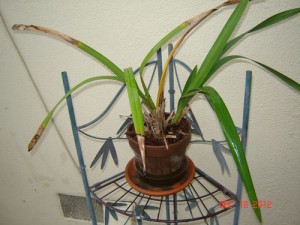What happened to my orchid
 Question from Patricia:
Question from Patricia:
Merry Christmas!
I admit I’ve been rather embarrassed to ask you this question, but here ’tis: What happened to my orchid? The main plant is discolored at the ends, but the newbie shoot seems very healthy!?!
I left it planted in bark, but now I’m wondering what exactly happened. I feed it starting in November — is this the result of “over-feeding?” I didn’t think I did, but what else is this?
Bless you, and have a wonderful New Year!!
Answer from Pat:
This cymbidium is suffering from being in too large a container. Also, it has been sitting in a saucer. This is a no-no. Throw away the saucer. Your first photo showed that the roots are too wet. They were drowning in drainage water or rain water in the bottom. This rots roots.
Next take it out of this container and fit the roots down into a small plastic pot, just big enough to fit what healthy roots are left. (Looks as if 4 inch or at the most 6-inch size would be large enough.) Then use a dowel or similar object to jam some clean bark tightly around the roots. Fertilize once a month with any balance fertilizer. (For you if this is your only plant, houseplant liquid fertilizer is fine but it must pour away so plant is not standing in it.) Fish emulsion would be fine too. Water once a week in winter or even none if it is out in the rain and roots stay moist. Water enough so it drains out the bottom and roots are moist but never soggy. Fertilize year round. Keep outdoors.
As far as the brown goes, this is common with stressed cymbidiums, just cut it off. It is a sign of salt damage. Your cymbidium is growing and can easily be saved from disaster if you follow what I have suggested above.


AHHHHH – merci beaucoup! Consider it done! Happiest New Year to you . . . and I hope to see you at Rogers this spring.
Rogers Gardens has already engaged me as a speaker for next year. Currently I am scheduled to speak at Rogers Gardens, at 9:00 a.m. on April 20, 2013. Hope to see you then.
Hope you’re having a wonderful New Years Eve.
Just a couple more beginner questions . . . believe me, I am learning much. Q. 1 When is the right time to replant an indoor Phalaenopsis? Is January too early? It looks like the flower stem has begun to grow. Q. 2: Why are the edges of my poinsettia turning black? I fed it with very diluted indoor plant food. It’s sitting in a North-Western corner of the house. Perfect Orchid/African violet lighting. I’d hoped it would be happy, but I’m not sure what happened? Any ideas? (BTW ~ It sounds funny, but my newly “barked” cymbidium already looks happier! As always, many many thanks!! 😉
Moss orchids (Phaleanopsis) can be repotted any time of year except when they are in bloom. Black or brown leaf edges on poinsettias can come from drafts or, if the black marks are on the colorful bracts, this comes from physical bruises. Some varieties have brilliant red bracts. Others have dark red bracts that may be almost black close to the tiny central flower. The variety ‘Annette Hegg’ has this characteristic. Potted poinsettias do not last long. If you want to grow a large poinsettia tree in your garden, you should begin by purchasing a special outdoor variety. It is best to consider the poinsettias we purchase seasonally in the market or at a nursery as holiday plants. It’s really not cost or time-effective to keep these growing and try to bring them back into bloom. So, toss them out when the holidays are over and get another the following year. If despite this advice, you want to grow them longer or grow them outdoors, check my book for instructions and varieties.